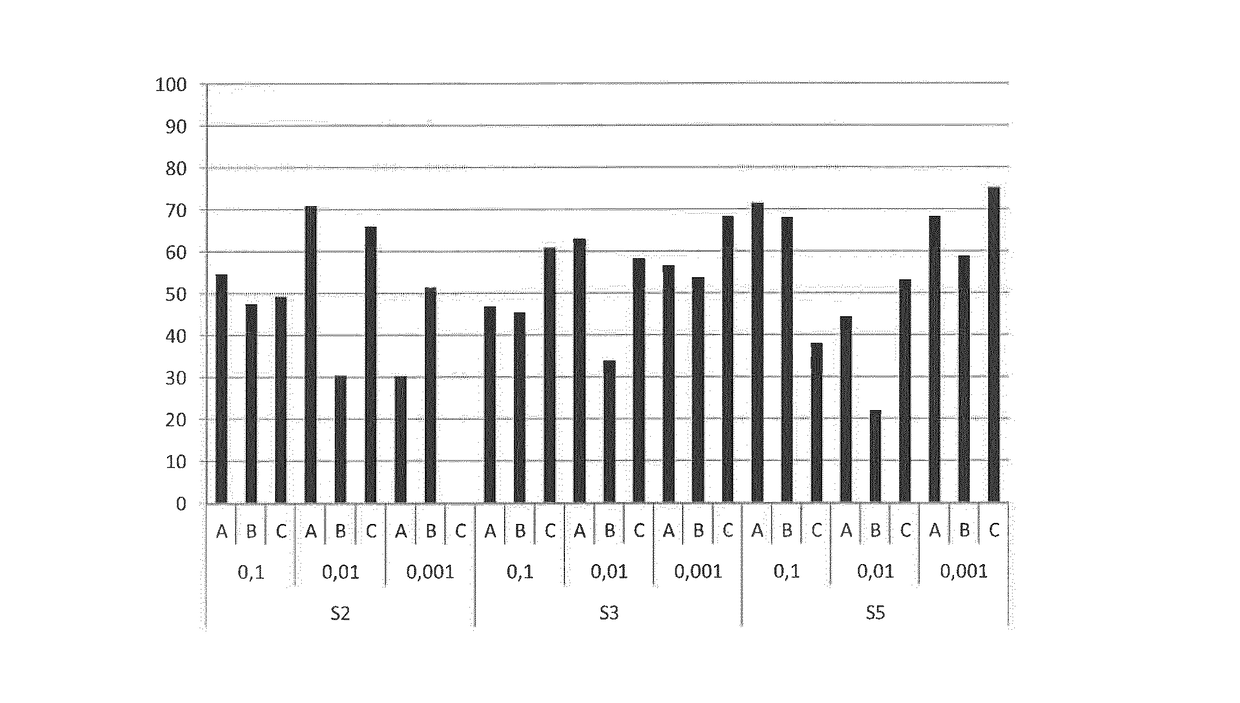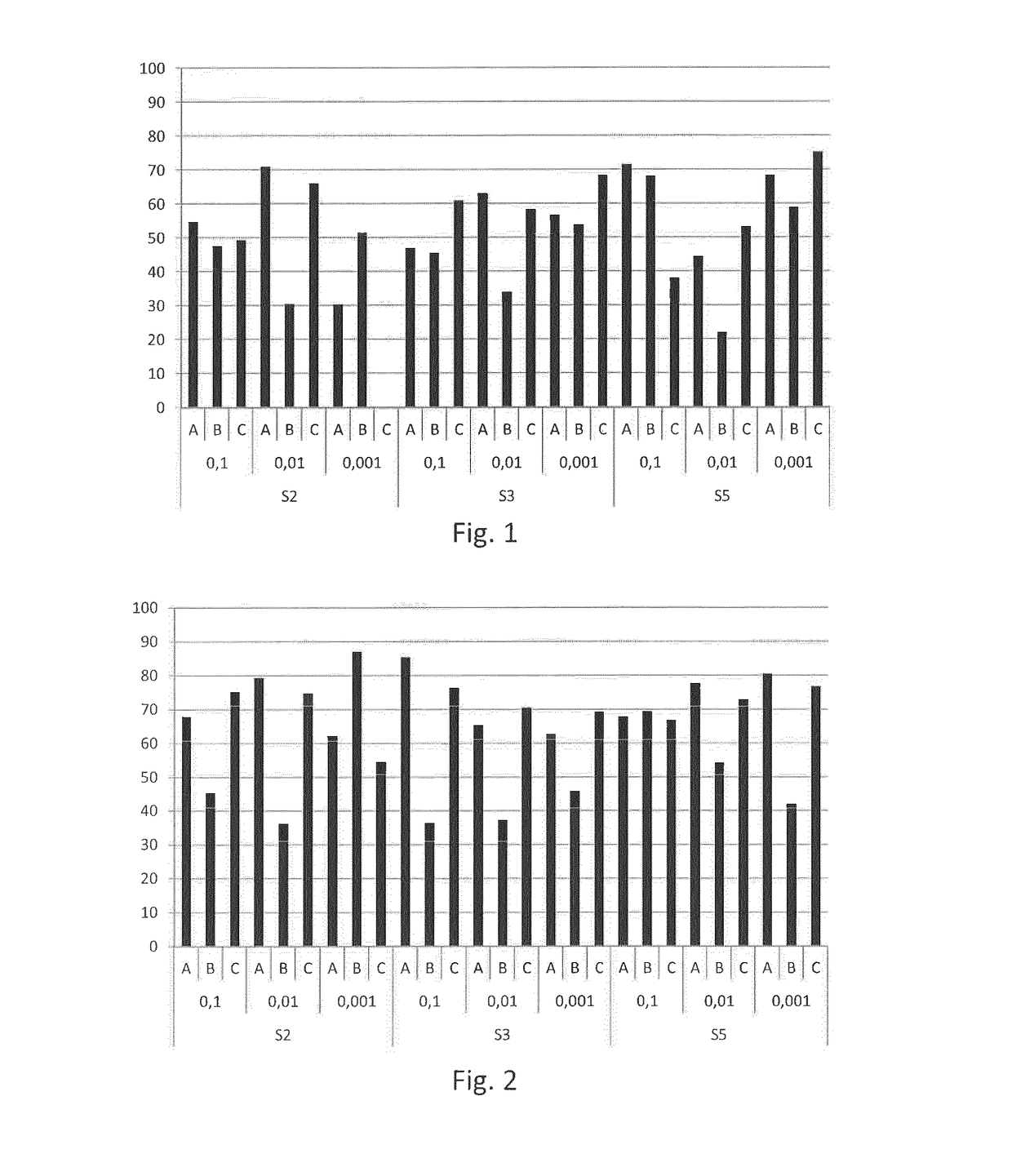Method for reducing adhesion of microorganisms to fabrics
- Summary
- Abstract
- Description
- Claims
- Application Information
AI Technical Summary
Benefits of technology
Problems solved by technology
Method used
Image
Examples
example 2
Method for the Quantitative Determination of the Adhesion of Microorganisms to Fabrics (Syto9 Assay)
2.1 Production of the Fabric Titer Plates
[0261]Circular fabric samples with a diameter of 0.6 cm were punched from coated and uncoated cotton and polyester fabrics. The fabric samples were fixed to a microtiter plate. The fabric samples were washed with acetone and sterilized with UV light for 60 minutes.
2.2 Bacterial Culture and Bacterial Propagation
[0262]Model microorganisms used were various gram-positive and gram-negative bacteria and yeasts, more particularly Pseudomonas aeruginosa (P. aeruginosa), Escherichia coli (E. coli), Staphylococcus aureus (S. aureus), Staphylococcus epidermidis (S. epidermidis) and Candida albicans (C. albicans).
[0263]The strains were coated fresh from glycerol bacterial cultures onto tryptic soy agar (TSA). Incubation took place overnight at 33° C. The nutrient medium prepared was a tryptic soy broth (TSB), with 30% of the amount recommended by the manu...
example 3
Investigation of the Finished Polyester Fabric Samples
3.1 Determinations of the Antiadhesive Effect with Respect to Various Microorganisms
[0278]As described in example 1, polyester fabric samples were each finished with a hydrophilic silane derivative S1 to S5, to give application concentrations on the fabric of 0.1 wt % (hydrophilic silane derivative S, based on total amount of coated fabric). The commercial products described in example 1 were applied directly by a padding method to polyester fabric samples.
[0279]Bacterial adhesion to the polyester fabric samples was investigated using the microtiter plate Syto9 assay, as described in example 2.
[0280]For this purpose, polyester fabric samples with a diameter of 0.6 cm were punched out and transferred to a 96-well microtiter plate. The adhesion of S. aureus DSMZ 20231 and P. aeruginosa DSMZ 1117—as representative examples of gram-positive and gram-negative bacteria—was determined as described in example 2, with the adhered bacteria...
example 4
Investigations on the Adhesion of Microorganisms to a Glass Surface
4.1 Production of the Coated Glass Samples
[0303]Silane derivatives S1, S3, S4 and S5 as identified above in example 1 were used to produce coatings on glass slides. As a control (comparison sample) K, an uncoated glass slide cleaned with isopropanol was used.
[0304]For the coating of the slides they were immersed for 60 seconds into a 0.1% strength solution of the corresponding silane derivative in ethanol / water as solvent with a water fraction of 5%. The solutions had been adjusted with acetic acid beforehand to a pH in the range from 4 to 5. The wetted slides were subsequently dried at 160° C. for 1 hour.
4.2 Determination of the Bacterial Adhesion Via Fluorescence Microscopy
[0305]The slides wetted with the bacterial suspension were analyzed by microscope to determine the adhering bacteria. For this purpose, the test culture itself was admixed with a fluorescent dye, which labels the adhering bacteria and hence label...
PUM
| Property | Measurement | Unit |
|---|---|---|
| Composition | aaaaa | aaaaa |
| Adhesion strength | aaaaa | aaaaa |
| Hydrophilicity | aaaaa | aaaaa |
Abstract
Description
Claims
Application Information
 Login to View More
Login to View More - R&D
- Intellectual Property
- Life Sciences
- Materials
- Tech Scout
- Unparalleled Data Quality
- Higher Quality Content
- 60% Fewer Hallucinations
Browse by: Latest US Patents, China's latest patents, Technical Efficacy Thesaurus, Application Domain, Technology Topic, Popular Technical Reports.
© 2025 PatSnap. All rights reserved.Legal|Privacy policy|Modern Slavery Act Transparency Statement|Sitemap|About US| Contact US: help@patsnap.com



